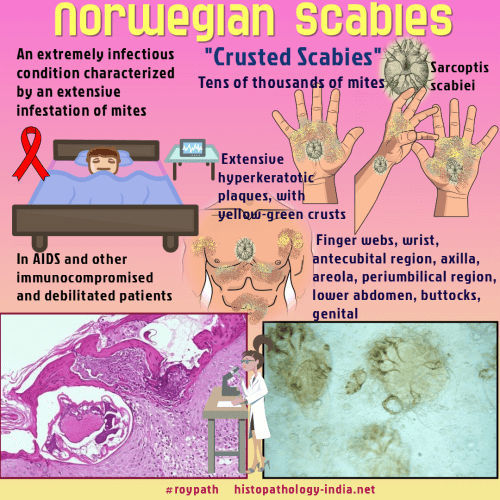|

Custom Search
|
|
Infectious Disease Online Pathology of Norwegian (Crusted) Scabies 2022 Norwegian (Crusted) scabies, a rare variant of classical scabies, is a highly contagious condition in which the skin is infected with thousands to millions of mites.It is a generalized severe scabies infestation usually affecting immunocompromised patients.
|

 |
|
Norwegian or Crusted
Scabies is a severe infestation of
Sarcoptes scabiei in which the mite load
is extremely high in comparison to traditional scabies. It is also called Norwegian scabies because it was described in Norway by Danielssen and Boeck as a type of scabies infestation caused by millions of mites in patients with leprosy. The authors studied cases of scabies in patients with sensory paresthesias, cognitive impairment, physical disability, and immunosuppression. Conventional scabies harbors less than fifteen Sarcoptes scabiei mites and requires fifteen to twenty minutes of close contact for transmission, whereas Norwegian Scabies typically infects immunocompromised and debilitated individuals with tens of thousands of mites. Given the vast mite load, Norwegian Scabies is extremely infectious and results in a significantly increased transmission risk to others within contact. It is common in patients with sensory neuropathy, mentally retarded persons and in patients who are immunosuppressed,(Example:In conditions like HIV, HTLV-I and systemic lupus erythematosus). Further, crusted scabies can rarely present as erythroderma (<0.5% cases). On presentation, patients often display extensive hyperkeratotic plaques, with yellow – green crusts, most commonly on the torso, extremities, face, and scalp. It can also present as warty dermatosis of the hands and feet, dystrophic nails with subungual hyperkeratosis and debris. In Norwegian (crusted) scabies, microscopic sections show multiple mites within the hyperkeratotic stratum corneum. The epidermis is often spongiotic. A superficial and deep dermal infiltrate composed of lymphocytes, histiocytes, mast cells, and eosinophils is characteristic. A hyperkeratotic psoriasiform dermatitis is present in the Norwegian (Crusted) Scabies. Eggs, larvae, and adult mites are abundant in the cornified layer of Norwegian scabies. Treatment for crusted scabies is difficult in some cases because of the large number of mites, forming hyperkeratotic areas in the skin. Therefore, a prolonged treatment with systemic scabicides is recommended, paying special attention to occacional concomitant infections. Summary -It is a severe, debilitating disease characterized by large numbers of mites, high immunoglobulin E (IgE) levels, peripheral eosinophilia, and the development of hyperkeratotic skin crusts that may be either loose, scaly, and flaky or thick and adherent The distribution over the body can be localized or extensive and can include the neck, scalp, face, eyelids, and the area under the nails.
|
|
|
 |


